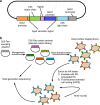In vitro evolution of an influenza broadly neutralizing antibody is modulated by hemagglutinin receptor specificity
- PMID: 28504265
- PMCID: PMC5440694
- DOI: 10.1038/ncomms15371
In vitro evolution of an influenza broadly neutralizing antibody is modulated by hemagglutinin receptor specificity
Abstract
The relatively recent discovery and characterization of human broadly neutralizing antibodies (bnAbs) against influenza virus provide valuable insights into antiviral and vaccine development. However, the factors that influence the evolution of high-affinity bnAbs remain elusive. We therefore explore the functional sequence space of bnAb C05, which targets the receptor-binding site (RBS) of influenza haemagglutinin (HA) via a long CDR H3. We combine saturation mutagenesis with yeast display to enrich for C05 variants of CDR H3 that bind to H1 and H3 HAs. The C05 variants evolve up to 20-fold higher affinity but increase specificity to each HA subtype used in the selection. Structural analysis reveals that the fine specificity is strongly influenced by a highly conserved substitution that regulates receptor binding in different subtypes. Overall, this study suggests that subtle natural variations in the HA RBS between subtypes and species may differentially influence the evolution of high-affinity bnAbs.
Conflict of interest statement
The authors declare no competing financial interests.
Figures





Similar articles
-
A small-molecule fragment that emulates binding of receptor and broadly neutralizing antibodies to influenza A hemagglutinin.Proc Natl Acad Sci U S A. 2018 Apr 17;115(16):4240-4245. doi: 10.1073/pnas.1801999115. Epub 2018 Apr 2. Proc Natl Acad Sci U S A. 2018. PMID: 29610325 Free PMC article.
-
Cross-neutralization of influenza A viruses mediated by a single antibody loop.Nature. 2012 Sep 27;489(7417):526-32. doi: 10.1038/nature11414. Epub 2012 Sep 16. Nature. 2012. PMID: 22982990 Free PMC article.
-
Recurring and Adaptable Binding Motifs in Broadly Neutralizing Antibodies to Influenza Virus Are Encoded on the D3-9 Segment of the Ig Gene.Cell Host Microbe. 2018 Oct 10;24(4):569-578.e4. doi: 10.1016/j.chom.2018.09.010. Cell Host Microbe. 2018. PMID: 30308159 Free PMC article.
-
Structural insights into key sites of vulnerability on HIV-1 Env and influenza HA.Immunol Rev. 2012 Nov;250(1):180-98. doi: 10.1111/imr.12005. Immunol Rev. 2012. PMID: 23046130 Free PMC article. Review.
-
Implications of broadly neutralizing antibodies in the development of a universal influenza vaccine.Curr Opin Virol. 2016 Apr;17:110-115. doi: 10.1016/j.coviro.2016.03.002. Epub 2016 Mar 28. Curr Opin Virol. 2016. PMID: 27031684 Free PMC article. Review.
Cited by
-
Hierarchical sequence-affinity landscapes shape the evolution of breadth in an anti-influenza receptor binding site antibody.Elife. 2023 Jan 10;12:e83628. doi: 10.7554/eLife.83628. Elife. 2023. PMID: 36625542 Free PMC article.
-
Multistate design of influenza antibodies improves affinity and breadth against seasonal viruses.Proc Natl Acad Sci U S A. 2019 Jan 29;116(5):1597-1602. doi: 10.1073/pnas.1806004116. Epub 2019 Jan 14. Proc Natl Acad Sci U S A. 2019. PMID: 30642961 Free PMC article.
-
Improved HIV-1 neutralization breadth and potency of V2-apex antibodies by in silico design.Cell Rep. 2023 Jul 25;42(7):112711. doi: 10.1016/j.celrep.2023.112711. Epub 2023 Jul 11. Cell Rep. 2023. PMID: 37436900 Free PMC article.
-
Sequence signatures of two public antibody clonotypes that bind SARS-CoV-2 receptor binding domain.Nat Commun. 2021 Jun 21;12(1):3815. doi: 10.1038/s41467-021-24123-7. Nat Commun. 2021. PMID: 34155209 Free PMC article.
-
High-throughput synthesis and specificity characterization of natively paired antibodies using oPool+ display.bioRxiv [Preprint]. 2025 Feb 28:2024.08.30.610421. doi: 10.1101/2024.08.30.610421. bioRxiv. 2025. PMID: 39257766 Free PMC article. Preprint.
References
-
- Hurt A. C., Holien J. K., Parker M. W. & Barr I. G. Oseltamivir resistance and the H274Y neuraminidase mutation in seasonal, pandemic and highly pathogenic influenza viruses. Drugs 69, 2523–2531 (2009). - PubMed
Publication types
MeSH terms
Substances
Grants and funding
LinkOut - more resources
Full Text Sources
Other Literature Sources
Medical
Molecular Biology Databases

